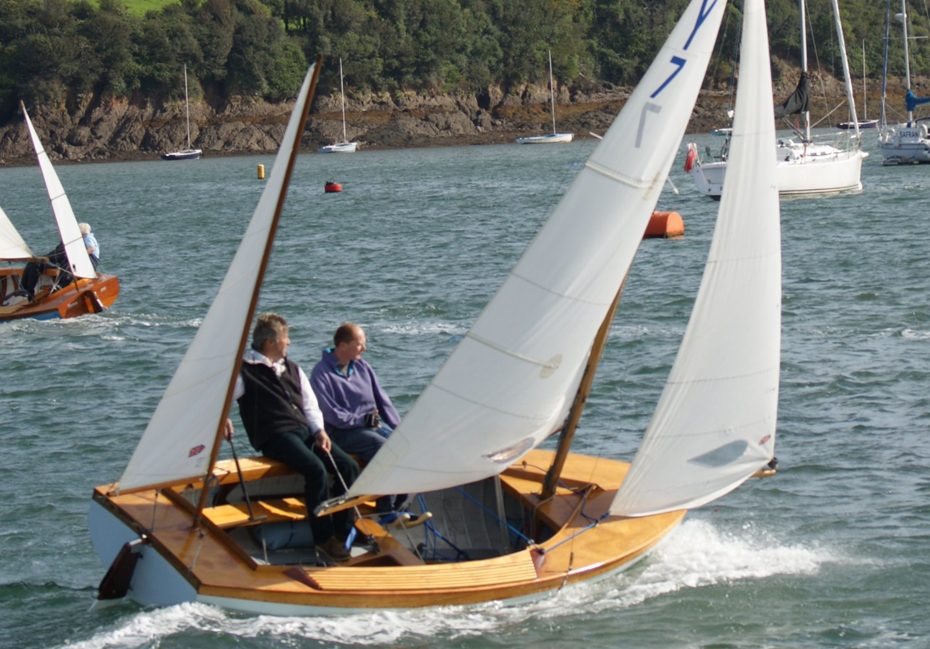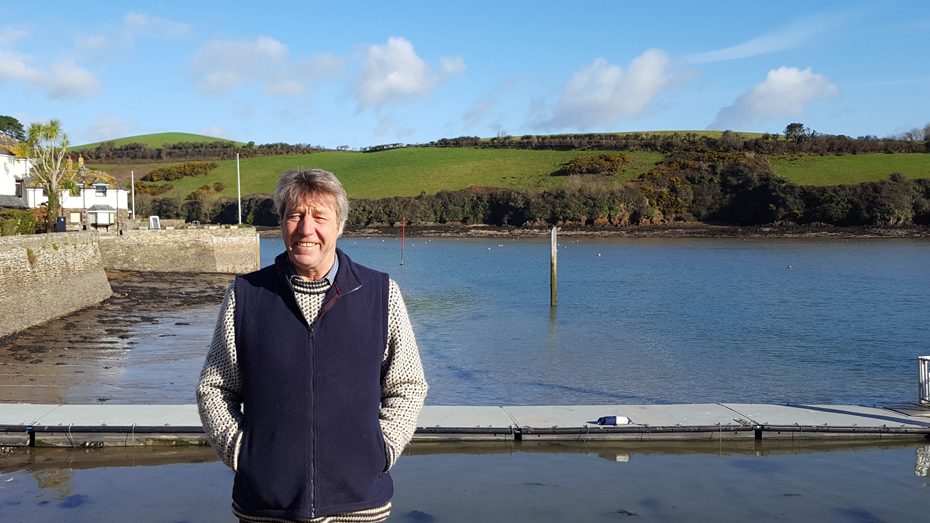Salcombe sailing: A complete guide to sailing in Salcombe
Sailing is by far one of the most popular pastimes in Salcombe with both visitors and locals alike. Salcombe...

The much-loved Salcombe yawl is famed for its craftsmanship, fine balance and manoeuvrability. These unique sailing boats can be seen on Saturdays racing around Salcombe harbour. They gather in far greater numbers during the regattas, with up to 20 racing at a time.
Who better to tell us more about the Salcombe yawl than local legend Bill ‘Scratch’ Hitchen, a man with 45 years experience on the water?
Raised in East Portlemouth, Scratch sailed out of Salcombe harbour as a 14-year-old cabin boy, and had navigated the world five times by the age of 19. After leaving the merchant navy, he returned to Salcombe and spent 17 years as a shell fisherman.

These days, Scratch spends his time taking people out on his own Salcombe yawl, teaching them the basics of sailing as well as sharing some of his deep knowledge of the area.
You can also hire a 18 ft launch from Scratch. Its licensed for up to eight people and dogs are welcome too.
At the start of our conversation, I asked Scratch to describe the Salcombe yawl and what makes it distinctive.
‘The Salcombe yawl is absolutely unique to Salcombe,’ he said. ‘It’s derived from old fishing boats from the turn of the 20th century, and if you see the old sailing trawlers, they’ve got three sails: they have a bowsprit on one end and a mizzen on the other, and the bowsprit supports the jib. The reason to have a yawl rig is that it makes it so manoeuvrable. It’s like a big lever on each end of the boat.’
‘The yawls that they race now were designed by a man called Jim Stone from East Portlemouth, and in 1936 he designed the first racing Salcombe yawl as we see today. There have been 189 of them built. They’re made of mahogany on elm predominantly. A few have been built of spruce but that’s quite rare. Spruce is a lot lighter so it’s good for racing, although there is a minimum weight for entering races and the rules are quite strict on that.’
‘On a Saturday we have about 12 or 14 in a race. During a regatta, there’ll be as many as 60 racing and they have to split them into them into three different fleets – 60 is too many to have them on the start line.’
Interested in buying a Salcombe yawl? Scratch says he’s seen plenty of people tempted into making a purchase after going out on one – so if you’re prone to impulse purchases, best beware before booking a lesson!
The Salcombe Yawl Owners’ Association has lots of information for those interested in purchasing a Salcombe yawl, and Scratch had some advice too:
‘A few years ago, Salcombe yawls were selling for up to £50,000. These days you can buy a nice racing yawl in good condition for £8,000 to £10,000 or maybe a bit less than that now.’
‘The first rule of the Salcombe yawl is that they’re predominantly a family day boat. Their secondary use should be for racing.’
The Salcombe Yawl inspires huge affection from its owners. I asked Scratch why he thought that was.
‘They’re such beautiful boats to sail. Sailing dinghies are usually quite ‘tippy’ – they’re over-canvassed like a car with too big an engine. When they’re sailed in a force 2-3 wind, about 12 notts, I don’t think there’s a nicer boat to sail than the Salcombe yawl. They’re so well balanced – you can have one finger on the tiller and one on the mainsail.’
‘They’re made of mahogany which is actually not the best of woods, especially in Salcombe. We have a type of worm called a gribble and it does like mahogany. It doesn’t like pine, it doesn’t like spruce or anything that’s got resin in it. Mahogany’s not got resin in it, so they’re very vulnerable to a bit of gribble and rot.’
‘Salcombe yawls need taking care of – you’ve got to keep mahogany boats away from fresh water, watch out for gribble and make sure they’re well painted and kept dry. A lot of the yawls here are only put into race for two hours on a Saturday and then they come out and go on the boat park.’
When talking to someone with Scratch’s breadth and depth of knowledge, the temptation to digress is ever-present. He comes across as a natural teacher, perhaps not surprising given that his mother was the last headmistress of East Portlemouth school.
Scratch talked me through the old way of forging frames for boats from wood, which involved entering the forest and finding branches that had fortuitously formed a workable shape. Later, the technique of steaming the wood and bending it into shape developed. Hearing about both these methods brings home the feeling that wooden boats are living animals, unlike their modern fibreglass or aluminium alternatives.
‘If you’ve got a fibreglass boat, it’s dead, isn’t it?’ said Scratch. ‘It’s very practical – it’s not going to get infected with gribble – but they say if God wanted fibreglass boats he’d have bought fibreglass trees!’
We moved on to talk more about the service Scratch provides in Salcombe.
10% OFF tuition, cruises and boat hire
Mention Coast & Country Cottages when you get in touch with Scratch and you’ll receive a 10% discount.
Call 01548 561619 or 07966 840436 or email scratchdevon@gmail.com.
‘I used to take a lot of people racing, but actually I found it a bit stressful. Everybody wants to win and not everyone can. If something goes wrong, you feel a bit guilty about it. I think I’m going to race this summer with my youngest grandson, but that’s just for pleasure.’
‘Predominantly, I like taking people out for a really nice sail around the harbour. In doing that, I’ll show them little things that the guidebooks never would. I know when I’ve done a good job because people are so appreciative and that gives me a lot of pleasure.’
I really like taking couples who want an introduction to sailing. It doesn’t matter if they’ve never sailed before. I’ll slowly introduce them to it and say simple things like ‘Hold that’. After half an hour or so, I’ll say, ‘Do you want to have a steer?’ As opposed to learning about dozens of knots, which you can learn later, they’ll just enjoy sailing and get a feel for it. You can learn the other stuff in a book over the winter if you want.’
‘I even advertise that dogs are welcome. Last year a couple brought a lurcher and an Alsatian with them – the dogs took up almost as much space as they did, but it didn’t matter.’

Finally, I wanted to know more about the kinds of people Scratch is set up to serve.
‘I’ll take anybody. The only exception is that I’m not so keen on taking kids who are pushed into it. It’s OK if the parents come with them, but I’m not really set up for them by themselves – it tends to be better if they learn somewhere where there are other kids.’
‘I’ve also got a launch called Ibis that’s for hire daily or weekly. I’ll even take people for a cruise on the launch if they don’t want to sail themselves. I can show them and tell them things about sailing and the harbour, and they’ll be amazed at how much they can learn.’
‘There’s certainly no pressure – I can usually quickly tell what people want to know and aren’t interested in.’
We ended our conversation there, but I for one could have easily continued chatting all day. Fitting for someone whose live has been filled with such adventure, Scratch has written an autobiography which will be published this year by Matador (title to be confirmed).
Whether you’re interested in learning to sail, topping up your skills, enjoying a few river cruises or racing around the harbour, there are all the waterborne options you need in Salcombe, Dartmouth and the surrounding South Devon area.
Why not book a well-deserved break today?